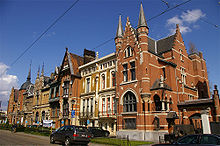Zurenborg
Zurenborg is an area in south-east Antwerp largely developed between 1894 and 1906 that features a high concentration of townhouses in Art Nouveau and other fin-de-siècle styles.
Art Nouveau houses are interspersed with neoclassical mansions and other eclectic architectural styles throughout Zurenborg, which straddles the boundary between Antwerp itself and the district of Berchem.
[1] The development of Zurenborg coincided with the peak of Art Nouveau popularity, and that movement had the greatest impact on the stylistic language of the area.
[1] The influence of organic and natural sources is particularly evident in the themes and names of the Art Nouveau homes: The Sunflower, The Rose, The Tulip, etc.
One of them, Waterloostraat 30, is adorned with a silhouette of Napoleon in his characteristic headgear, while another is decorated with glazed ceramic panels depicting scenes from that battle.
Examples of such a grouping are on the four corners of the Waterloostraat and Generaal Merlenstraat intersection, where houses depicting the four seasons face one another: Lente (Spring), Zomer (Summer), Herfst (Autumn) and Winter.
[1] With car ownership rising and upper middle class households moving to the suburbs, the status of Zurenborg - especially Cogels Osylei - as a well-to-do residential area came down.

